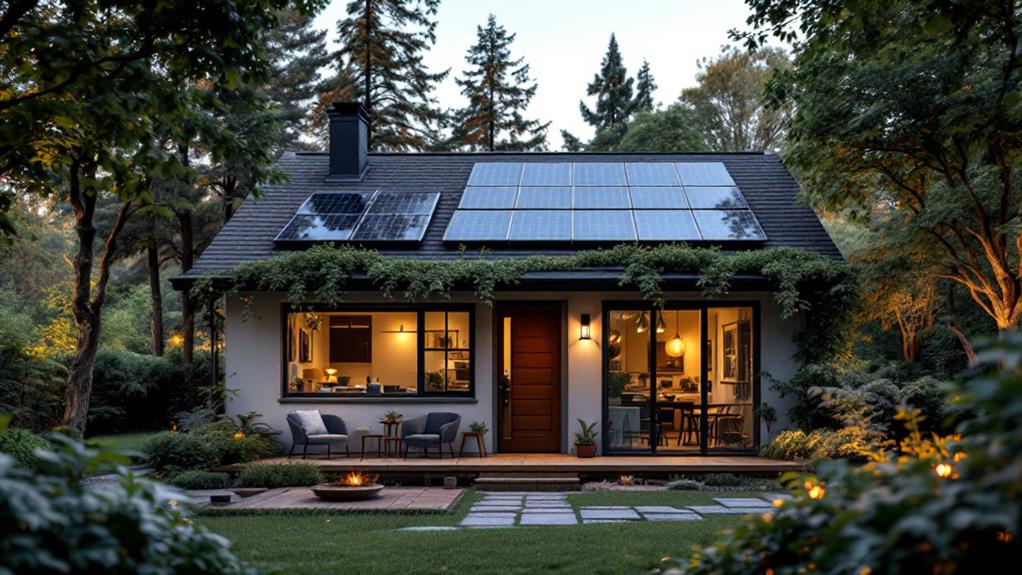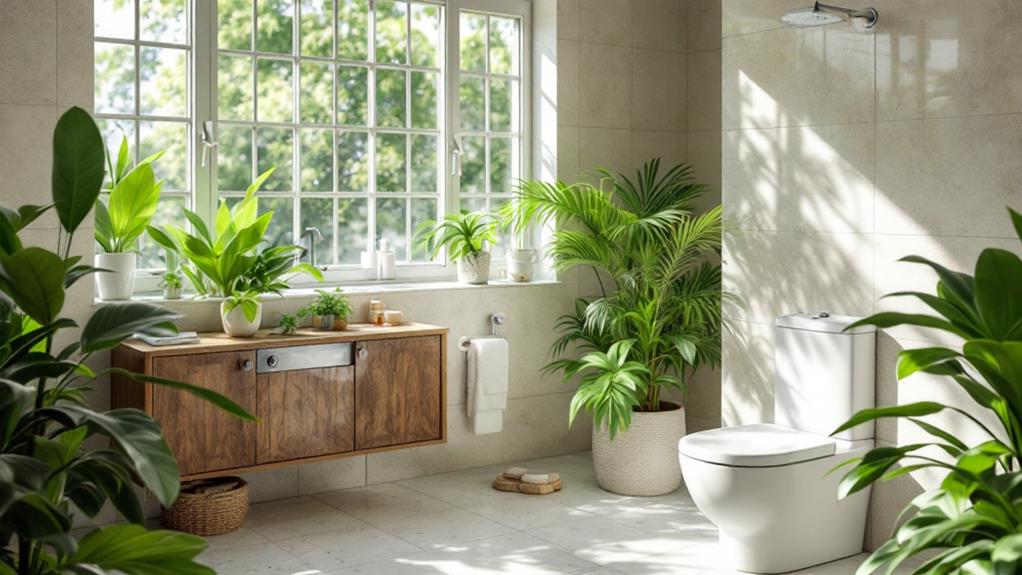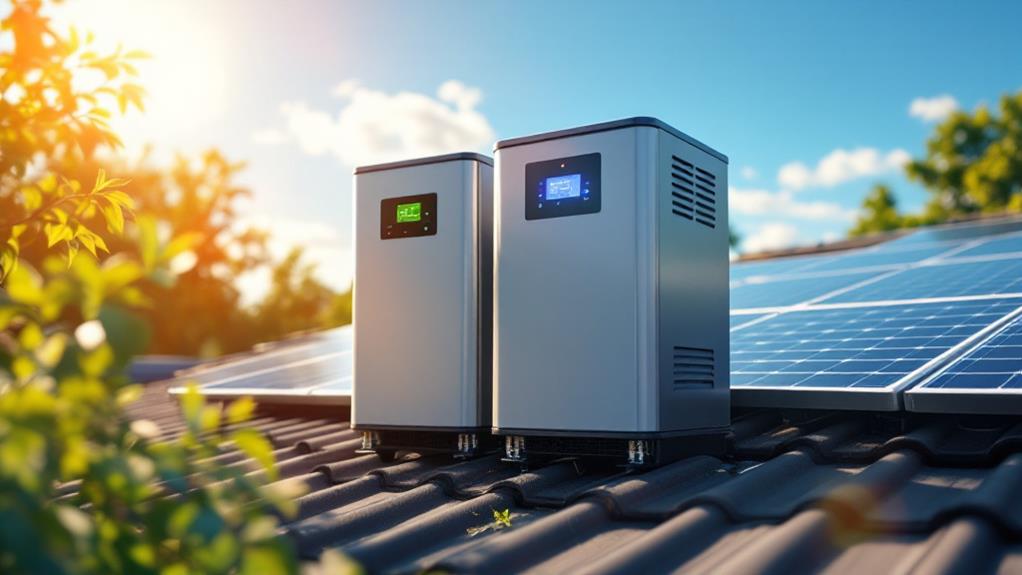Tips for Easily Limiting Your Energy Costs at Home

To easily cut your energy costs at home, start by replacing incandescent bulbs with LED lighting for immediate savings. Set your thermostat smartly by using scheduling features to save when you're away or asleep. Unplug idle electronics or use smart power strips to avoid energy vampires. Opt for Energy Star-rated appliances and maintain them well for top efficiency. Seal gaps around doors and windows and insulate your home to prevent heat loss. Utilize smart home tech like smart plugs and energy monitors. Adopting water-saving techniques is also key. There's much more you can investigate in this area.
Upgrade to LED Lighting
Upgrading to LED lighting is one of the simplest and most effective ways to cut down on your energy costs at home. LED bulbs consume remarkably less electricity than traditional incandescent or fluorescent lights, reducing your utility bills and your carbon footprint. When you switch to LEDs, you'll notice not only the savings but also the superior lighting quality. LED color temperature options allow you to customize the ambiance of your home. Regardless of whether you prefer a warm, cozy glow or a bright, cool daylight effect, LED bulbs cater to all preferences.
Moreover, many LED lights come with dimmable options, giving you control over the brightness and mood of each room. This is particularly advantageous in spaces like living rooms or dining areas where lighting needs can vary. By dimming the lights, you also extend the lifespan of your bulbs while saving energy. Start by replacing the most frequently used lights, such as in kitchens or hallways, to optimize your savings from the get-go. Making this change to LED lighting is a straightforward and impactful step towards a more energy-efficient home, benefiting both your wallet and the environment.
Optimize Thermostat Settings
While switching to LED lighting lays the foundation for a more energy-efficient home, adjusting your thermostat settings can further improve your savings. By optimizing your thermostat, you can maintain comfort without wasting energy. Start by utilizing thermostat scheduling. Program your thermostat to lower the temperature when you're asleep or away from home, and set it to a comfortable level shortly before you return. This simple step guarantees you're not heating or cooling an empty house, which can greatly reduce your energy bills.
Temperature programming is another effective strategy. Set your thermostat to a few degrees warmer in the summer and cooler in the winter when you're home. Each degree of adjustment can lead to considerable savings over time. Many modern thermostats offer smart programming features, allowing them to learn your habits and adjust settings automatically. You can also control these thermostats remotely through smartphone apps, so you can make adjustments even when you're on the go.
Unplug Idle Electronics

Reducing energy waste often starts with unplugging idle electronics. Many devices continue to draw power even when they're turned off, earning them the nickname "energy vampires." You might not realize it, but your phone charger, gaming console, and coffee maker are secretly adding to your electricity bill. To combat these sneaky energy suckers, make it a habit to unplug electronics when they're not in use.
Consider using power strips to simplify the process. By plugging multiple devices into a single power strip, you can easily cut off power to several electronics with just one switch. This method is especially useful for home office setups or entertainment centers, where multiple gadgets are often left on standby mode. Just remember to flip the switch on the power strip when you're done for the day.
If manually unplugging devices seems too much of a hassle, invest in smart power strips. These advanced strips can detect when a device is in standby mode and automatically cut the power, saving you both time and energy. By taking these steps, you'll effectively reduce energy waste and enjoy lower electricity bills without sacrificing convenience.
Use Energy-Efficient Appliances
Switching to energy-efficient appliances is one of the most effective ways to cut down on energy costs at home. By choosing appliances with the Energy Star label, you guarantee they meet strict energy efficiency guidelines set by the Environmental Protection Agency. These appliances use less energy, which can markedly reduce your utility bills over time. It's not just about purchasing the right appliances, though; regular appliance maintenance is essential to keep them running efficiently.
Here are some tips to amplify the benefits of energy-efficient appliances:
- Choose Energy Star-rated appliances: Look for the Energy Star logo when buying new appliances, as they can save you money and reduce environmental impact.
- Regular maintenance: Schedule regular check-ups for your appliances to verify they're operating at peak efficiency. This includes cleaning filters, checking seals, and addressing any needed repairs promptly.
- Optimize usage: Use appliances like dishwashers and washing machines only with full loads to enhance efficiency.
- Consider smart appliances: Smart appliances can be programmed to run during off-peak hours, further reducing energy costs.
Seal and Insulate Your Home

To effectively limit energy costs at home, sealing and insulating your home can make a significant difference. Start by inspecting windows and doors for drafts that let cold air in and warm air escape. Installing weather stripping around doors and windows is an easy and cost-effective way to seal these gaps. You'll find that it not only reduces drafts but also helps maintain a consistent indoor temperature, reducing the need for heating and cooling.
In conjunction with weather stripping, consider using thermal curtains. These curtains are specifically designed to provide an extra layer of insulation. They help keep the cold out during the winter and block out heat in the summer. By using thermal curtains, you can reduce the strain on your heating and cooling systems, ultimately lowering your energy bills.
Don't forget to check your attic and basement for proper insulation. These areas are often overlooked, yet they can be major sources of heat loss. Upgrading insulation in these spaces can prevent heat from escaping, keeping your home warmer in the winter. By taking these steps to seal and insulate your home, you'll enjoy a more comfortable living environment while saving money on energy costs.
Embrace Smart Home Technology
With the advent of smart home technology, managing your home's energy efficiency has never been easier. You can take advantage of a variety of devices to monitor and control your energy usage effectively. Smart plugs, for instance, allow you to manage appliances remotely, ensuring they're not consuming power when not needed. This simple action can lead to significant savings on your energy bill.
Energy monitors give you real-time insights into your consumption patterns, helping you identify high-usage habits. By understanding where most of your energy goes, you can make informed decisions to reduce waste. Integrating these technologies into your home can be both simple and impactful.
Consider these steps to get started:
- Install Smart Plugs: Remotely turn off devices and prevent phantom power usage.
- Use Energy Monitors: Track real-time energy consumption and adjust habits accordingly.
- Automate Lighting: Set schedules for lights to switch off when rooms are unoccupied.
- Upgrade to Smart Thermostats: Optimize heating and cooling based on occupancy and preferences.
Adopt Water-Saving Techniques

While smart home technology helps you manage energy efficiently, water conservation is another critical area where you can make a considerable impact. By adopting water-saving techniques, you not only reduce your water bills but also contribute to environmental sustainability. Start by installing low flow fixtures in your home. These include faucets, showerheads, and toilets that use less water without compromising performance. They're affordable, easy to install, and can greatly cut your water usage.
Another effective strategy is rainwater harvesting. Set up a system to collect rainwater from your roof. You can use this water for gardening, flushing toilets, or even washing your car. It's a simple yet effective way to make use of a natural resource that would otherwise go down the drain.
Don't overlook the small changes, either. Fix leaky taps promptly and be mindful of your water usage habits. Turn off the tap while brushing your teeth and limit shower time. These actions may seem minor, but they add up over time, making a noticeable difference in your water consumption and bills. Adopting these techniques helps you conserve precious resources and save money.



